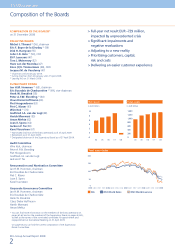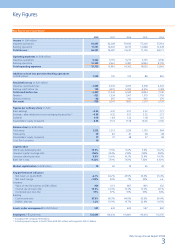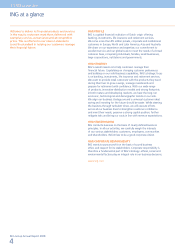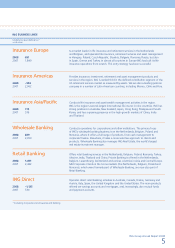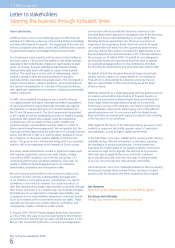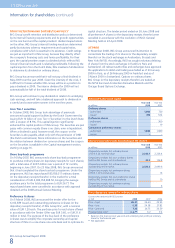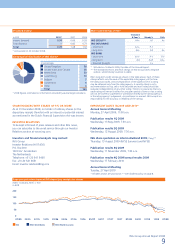ING Direct 2008 Annual Report Download - page 14
Download and view the complete annual report
Please find page 14 of the 2008 ING Direct annual report below. You can navigate through the pages in the report by either clicking on the pages listed below, or by using the keyword search tool below to find specific information within the annual report.
ING Group Annual Report 2008
1.2 Report of the Executive Board
12
Strategy (continued)
In January 2009, ING and the Dutch State reached an agreement
on an Illiquid Assets Back-up Facility term sheet covering ING’s
Alt-A residential mortgage-backed securities. Market prices for
these securities had become depressed as liquidity dried up, which
affected our results and equity far in excess of reasonably expected
credit losses. This transaction with the Dutch State as described in
the term sheet would significantly reduce the uncertainty regarding
the impact on ING of any potential future losses on 80% of the
portfolio. In 2009, we will continue to reduce our risk profile.
We believe in a strong risk management function that is fully
integrated into the daily management and strategic planning of
all our business units. ING aims to close this transaction in the first
quarter of 2009, but the closing is dependent on the completion
of final documentation and approval of various regulators.
Bringing costs in line with the operating environment
With pressure on margins and investment returns, it is vital to
contain costs. In 2009 we announced to cut operating expenses by
EUR 1 billion in 2009. The structural expense reduction is expected
to lead to annual savings of approximately EUR 1.1 billion from
2010 onwards. Of the cutback, 35% will come from a reduction of
the workforce by approximately 7,000 full-time positions in 2009.
The remainder of the expense reduction comes from decreasing
costs for our head office, marketing, the Formula 1 programme,
consultancy, third-party staff and the renegotiating of certain
contracts with IT-vendors.
By taking these measures we are bringing expenses in line with
the operating environment. This will make ING leaner and more
flexible as we position ourselves for an eventual recovery.
Long-term priorities
We are convinced that it is in the long-term interest of all
our stakeholders (customers, employees, communities, and
shareholders) to do whatever is necessary to maximise business
opportunities whilst maintaining the financial health and growth
prospects of our company. Our focus on banking, investments,
life insurance, and retirement services, enables us to provide retail
customers with the products they need during their lives to grow
savings, manage investments and prepare for retirement with
confidence. With our wide range of products, innovative
distribution models and strong footprints in both mature and
developing markets, we have the economic, technological and
demographic trends on our side.
We will continue to invest in our bank distribution platforms.
We are able to serve our 85 million customers through different
distribution channels – our direct banking channels and branches
and also through tied agents, and via distribution agreements with
other parties. Banks can fill many customer needs across a wide
range of products from liquidity to lending and investing. Banking
is also structurally well-positioned with many chances for customer
interaction and long customer retention.
But even with the right mindset and structure in place, shielding
customers from market risks while managing earnings volatility
remains a challenge, especially in the uncertain market environment
of today. Therefore, we also want to make sure that we continue
to be able to generate a good portion of our own assets as well.
Our wholesale banking activities will thus continue to play a
fundamentally important role, as our expertise in this field helps us
generate the high-quality assets in which we can invest our retail
deposits. Our wholesale banking business also provides us with
relevant skills in risk management, and gives us access to financial
markets around the world. Lastly, our asset management will
also remain key to our strategy. In order to optimise our asset
management skills we will further strengthen our capabilities and
investment expertise to deliver first-class investment performance
for our clients.
High-growth markets continue to play an important role for ING.
Yet, given the new economic and regulatory realities and the
necessity to preserve ING’s capital position, new investments will
be tempered.
While drawing lessons from the crisis and the debate on the
function of financial institutions in society, we will review the
portfolio of the company in terms of markets, distribution models
as well as product offering, in order to ensure our long-term
competitiveness. We will focus on fewer, coherent and strong
businesses. Also, we will simplify the organisation, improve
the fundamentals of our business and invest in improving
commercial processes.
Moreover, further strengthening of our brand around a
universal ideal of delivering an easier customer experience
remains a main objective, as awareness and appreciation of the
ING brand is essential in building trust, a key driver for long-term
business growth.
Last, but certainly not least, continued investment in our people
is essential. ING is proud to have highly skilled and motivated staff.
Hence, we will continue to promote people-oriented leadership,
and to drive for excellence.
CONCLUSIONS AND AMBITIONS
The global financial crisis made 2008 an extremely challenging year
for all financial institutions and ING was no exception. The sharp
market decline in 2008 has confronted us with significant
impairments and negative revaluations across almost all asset
classes. ING is confronting the crisis head-on by putting customers
first, preserving a strong capital position, further mitigating risks
and lowering costs.
While the global economy will be confronted with a recession in
2009, our first priority is to improve the financial fundamentals of
the company, without losing perspective on the long term. We
will assess our strategic focus and review our portfolio in the best
interests of our customers, the markets we want to be in, our
distribution models and our product offering. ING will pursue a
universal customer ideal: saving and investing for the future should
be easier.


